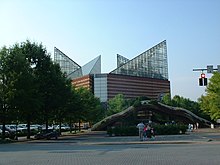Vision 2000 was a program in Chattanooga, Tennessee, established in 1984 by the nonprofit Chattanooga Venture. The program aimed to reduce city pollution, revive the downtown area, and build more housing. The program also sought to establish businesses and parks that would attract tourists to the city.
About 1,700 Chattanooga citizens participated in the Vision 2000 planning process, proposing and voting on 2,500 ideas to determine a final list of 40 goals. By 1992, Vision 2000 had led to the implementation of 223 programs and projects, most famously the Tennessee Aquarium.

History
In October 1969, Walter Cronkite declared Chattanooga the "dirtiest city in America" in a news broadcast, due to heavy pollution and smog from industrialization. Residents sometimes had to drive with headlights on during the day in order to see through the smog.
In 1984, Chattanooga Venture invited citizens to participate in devising Vision 2000, with the goal of addressing the effects of industrialization and improving Chattanooga as a place to live. Vision 2000 collaborated with another local group, the Moccasin Bend Task Force, to produce the 1985 "Tennessee Riverpark Master Plan", focusing on the Tennessee River as a potential center of revitalization.
James Rouse, an influential urban planner and philanthropist, praised Venture and its Vision 2000 as an example to cities across the country, saying " a very impressive spirit here that something is going to happen in this city."
Developments

Vision 2000 was involved in a number of city developments, including:
- the Riverwalk, a 16-mile path along the Tennessee River connecting various city attractions and points of interest, completed in 2005
- the Tennessee Aquarium, opened in 1992 as the world's largest freshwater aquarium
- repairs to, and reopening of, the long-closed Walnut Street Bridge, now one of the longest walking bridges in the world
- the Creative Discovery Museum, a downtown children's museum
- a movie theater
References
- ^ Smith, John Lukachick; McClane, Joan Garrett (August 2017). "Coming Together, Coming Apart". Chattanooga Times Free Press. Retrieved 6 April 2023.
- ^ "Why Would CT Want Gig Service?". Connecticut's Official State Website. Archived from the original on 18 July 2020. Retrieved 6 April 2023.
- ^ Kitheka, Bernard M.; Baldwin, Elizabeth D.; White, David L.; Harding, Daniel N. (4 September 2016). "A different "we" in urban sustainability: how the city of Chattanooga, TN, community defined their own sustainability path". International Journal of Tourism Cities. 2 (3): 185–205.
- ^ Gose, Joe (2022-09-09). "The 40-Year Vision That Revitalized Downtown Chattanooga". Urban Land. Retrieved 2023-04-06.
- "The City of Chattanooga, Tennessee". livable.org. Partners for Livable Communities. 2010. Retrieved October 11, 2015.
- Wiseman, Oliver (2021). "How Chattanooga Reinvented Itself". City Journal. Retrieved 2023-04-06.
- "Tennessee Aquarium History". Tennessee Aquarium. 2015. Retrieved October 11, 2015.
- ^ Jackson, Daniel (20 February 2019). "The Chattanooga That Will Be". The Chattanooga Pulse. Retrieved 6 April 2023.
- "Walnut Street Bridge, Chattanooga, Tenn". www.tennesseerivervalleygeotourism.org. Retrieved 2015-10-12.
- Kratz, Scott; Fritz, Marie J. "Chattanooga's Walnut Street Bridge". bridgepark.org. Retrieved October 12, 2010.